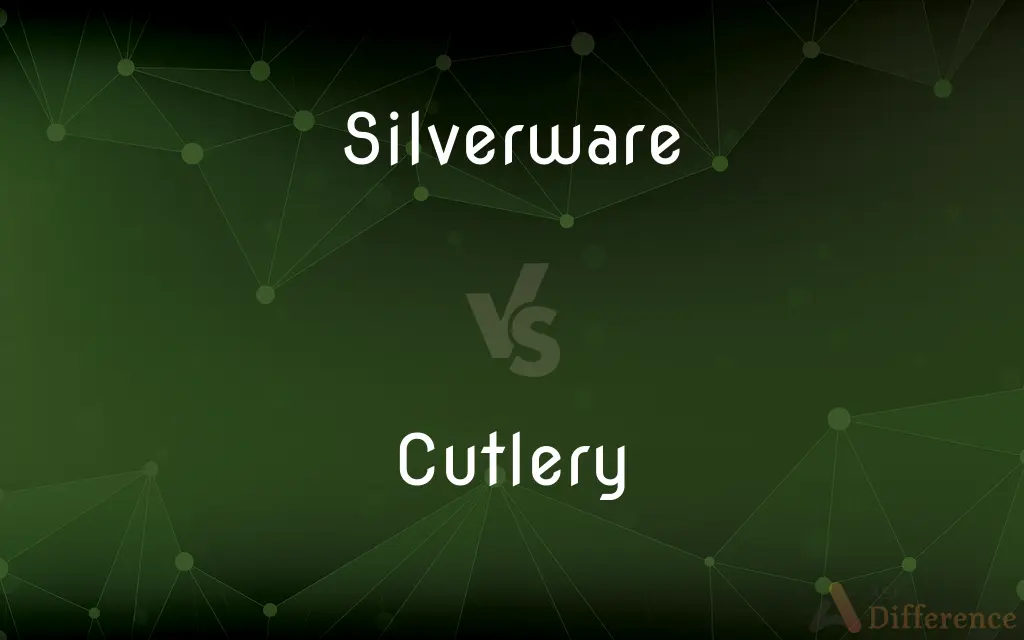Silverware vs. Cutlery — What's the Difference?
Edited by Tayyaba Rehman — By Urooj Arif — Updated on April 1, 2024
Silverware is typically made of silver or similar metals, used for formal occasions, whereas cutlery includes all eating and serving utensils, regardless of material.

Difference Between Silverware and Cutlery
Table of Contents
ADVERTISEMENT
Key Differences
Silverware, traditionally crafted from silver or silver-plated materials, conveys a sense of elegance and is often associated with formal dining and special occasions. Cutlery, on the other hand, encompasses a broader range of utensils made from various materials including stainless steel, plastic, and wood, catering to everyday use as well as formal settings.
While silverware is prized for its aesthetic appeal and durability, requiring special care to maintain its luster, cutlery made from materials like stainless steel or plastic offers practicality and ease of maintenance, making it a more common choice for daily meals.
The term "silverware" in American English often refers to all types of dining utensils, irrespective of their material, highlighting a cultural difference in terminology. In contrast, "cutlery" is a term more widely used globally to describe knives, forks, and spoons used for eating and serving food, without implying the material.
Collecting silverware can be seen as an investment or a hobby, with antique pieces being highly valued for their craftsmanship and history. Cutlery sets, while also available in designer and luxury variants, are generally more focused on functionality and design that complements modern kitchen aesthetics.
The maintenance of silverware involves regular polishing to prevent tarnishing, a result of silver reacting with sulfur-containing substances in the air. Cutlery made from stainless steel, however, is resistant to rust and tarnish, requiring minimal upkeep beyond standard cleaning practices.
ADVERTISEMENT
Comparison Chart
Material
Silver or silver-plated
Various (metal, plastic, wood)
Usage
Formal occasions, special events
Everyday meals, all occasions
Care
Requires polishing to prevent tarnish
Low maintenance, easy to clean
Cultural Significance
Often considered luxury items
Essential in daily dining and food preparation
Terminology
In the US, can refer to all dining utensils
Globally recognized term for eating utensils
Compare with Definitions
Silverware
Requires maintenance.
She polished the silverware meticulously before the holiday dinner.
Cutlery
Affordable options available.
For the picnic, they purchased disposable plastic cutlery.
Silverware
Can be a collector's item.
He added an antique silverware piece to his collection from the 19th century.
Cutlery
Used daily.
The family bought a new set of cutlery for their renovated kitchen.
Silverware
Used for formal dining.
For the gala dinner, the hosts brought out their finest silverware.
Cutlery
Functional designs.
The modern cutlery set featured ergonomic handles for better grip.
Silverware
Often gifted on special occasions.
The couple received a set of silverware as a wedding gift.
Cutlery
Made of various materials.
The cutlery set included stainless steel knives and forks.
Silverware
Made of silver.
The silverware set was passed down through generations as a family heirloom.
Cutlery
Easy to maintain.
After dinner, she put the cutlery in the dishwasher for easy cleaning.
Silverware
Hollowware and flatware made of or plated with silver.
Cutlery
Cutlery includes any hand implement used in preparing, serving, and especially eating food in Western culture. A person who makes or sells cutlery is called a cutler.
Silverware
Metal eating and serving utensils.
Cutlery
Knives, forks, and spoons used for eating or serving food.
Silverware
Anything made from silver.
Cutlery
Cutting instruments and tools.
Silverware
Anything with a silvery colour. en
Cutlery
Utensils such as knives, forks, and spoons used as tableware.
Silverware
(US) Knives, forks and spoons.
Cutlery
The occupation of a cutler.
Silverware
(sports) Trophies, success in a competition.
Cutlery
A collective ensemble of eating and serving utensils such as knives, forks and spoons.
A cutlery set
This cutlery comes from Normandy, France
Silverware
Dishes, vases, ornaments, and utensils of various sorts, made of silver.
Cutlery
The business of a cutler.
Silverware
Tableware made of silver or silver plate or pewter or stainless steel
Cutlery
The business of a cutler.
Cutlery
Edged or cutting instruments, collectively, especially knives for cutting food.
Cutlery
Eating utensils such as knives, forks, and spoons.
Cutlery
A cutting implement; a tool for cutting
Cutlery
Tableware implements for cutting and eating food
Common Curiosities
What is silverware?
Silverware refers to utensils made from silver or silver-plated materials, typically used for special occasions.
What is cutlery?
Cutlery includes knives, forks, and spoons used for eating and serving food, made from various materials.
Why is silverware considered special?
Silverware is often associated with luxury, elegance, and formal dining experiences.
Is stainless steel cutlery better than silverware?
Stainless steel cutlery is more practical for everyday use due to its durability and ease of maintenance.
Why do people collect silverware?
People collect silverware for its beauty, craftsmanship, historical value, and as an investment.
Is it necessary to have both silverware and cutlery?
Having both allows for appropriate utensils for different occasions, from daily meals to special events.
What makes cutlery ergonomic?
Ergonomic cutlery is designed for comfortable use, with handles that fit well in the hand.
Can silverware and cutlery be used interchangeably?
In the US, silverware can refer to all dining utensils, but globally, cutlery is the more commonly used term.
How do I choose between silverware and cutlery?
Choice depends on usage, with silverware preferred for formal settings and cutlery for everyday meals.
Can cutlery include plastic utensils?
Yes, cutlery can include utensils made from plastic, especially for casual or outdoor dining.
Can silverware be put in a dishwasher?
It's generally recommended to hand wash silverware to prevent damage and tarnishing.
How do cultural differences affect the use of silverware vs. cutlery?
Cultural preferences and dining practices influence the choice between silverware and cutlery, with some cultures valuing tradition and others prioritizing practicality.
How should silverware be maintained?
Silverware requires regular polishing to prevent tarnishing and maintain its shine.
Are there any health benefits to using silverware?
Historically, silver has been associated with antibacterial properties, but for modern use, the benefits are more aesthetic than health-related.
Can disposable cutlery be considered eco-friendly?
While traditionally not, there are now eco-friendly disposable options made from biodegradable materials.
Share Your Discovery

Previous Comparison
Lethargy vs. Fatigue
Next Comparison
Random vs. ArbitraryAuthor Spotlight
Written by
Urooj ArifUrooj is a skilled content writer at Ask Difference, known for her exceptional ability to simplify complex topics into engaging and informative content. With a passion for research and a flair for clear, concise writing, she consistently delivers articles that resonate with our diverse audience.
Edited by
Tayyaba RehmanTayyaba Rehman is a distinguished writer, currently serving as a primary contributor to askdifference.com. As a researcher in semantics and etymology, Tayyaba's passion for the complexity of languages and their distinctions has found a perfect home on the platform. Tayyaba delves into the intricacies of language, distinguishing between commonly confused words and phrases, thereby providing clarity for readers worldwide.














































